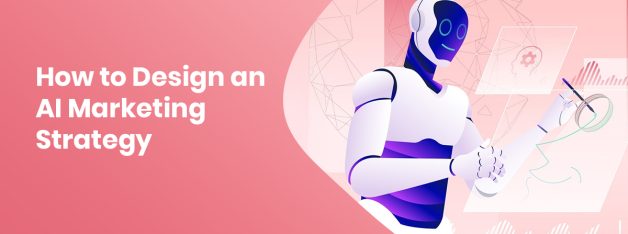How to Create a Marketing AI Strategy

A door has been flung open: the transmogrification across business functions by the digital revolution-artificial intelligence has been accepted in broad arms and weighs more especially on the marketer’s shoulders, where its efficient and proper deployment unlocks previously unprecedented potential. Whether in personalized customer experience or predictive analytics enhancing campaign effectiveness, such possibilities stretch far beyond even the grandest visioning of the tool’s most visionary users today.
It translates the innovation and creativity phases of technological steps to setting up a winning AI marketing strategy into performance measurement.
Why AI Matters in Digital Marketing
It’s one of those words that can only be used to speak of hype because AI can now be used for helping in making smarter business decisions, improving productivity, even personalization of efforts in marketing campaigns. This also further drives the merits it presents as agencies operating in digital commerce find the use of AI is no longer a choice but just a means for them to be relevant in the field.
Benefits of AI in marketing:
- Personalization: Custom content and recommendations about what users specifically do.
- Efficiency: Enables automation of ordinary jobs so that more time is set aside for high value work.
- Analytics: Leverage data in real time to make the most out of the campaigns and provide a forecast.
Step 1: Define your goals
Clear goals have to form the basis of any sensible strategy for AI marketing. What do you want to achieve with AI? Do you look for an improvement level of lead generation? Do you look forward to improving the levels of customer engagement? Or do you want to get improved conversion levels? You will have to realign business objectives with AI applications.
Pro Tip: Ensure that your goal is SMART – Specific, Measurable, Achievable, Relevant, and Time-bound so you are focused and clear.
Step 2: Audit existing capacities
Before bringing AI, audit the existing marketing systems, data infrastructure, and capabilities of the team. Audit in minute detail so that it is known from where the gaps are; what should be given priority for the impact that comes from AI?
Questions to Ask
Is there adequate data to train AI algorithms?
Are our systems compatible with the tools of AI?
Is your team ready for an AI-driven solution?
Step 3: Pick Your AI Tools
AI comes in all shapes and sizes-from simple chatbots to very complicated analytics platforms. The right tool for the right objective and business model has to be chosen for successful AI marketing implementation.
- Simple AI Tools in Marketing
- Chatbots: Auto-generated customer support, lead generation, etc.
- Predictive Analytics: Predicts customers’ behavior; refines the campaign accordingly
- Recommendation System: Gives the customer relevant products or content.
- Sentiment Analysis: Monitor and track customer sentiment through social media channels.
Step 4: Tying AI into Your Legacy Systems
Integrate AI solutions to your present marketing environment and gain maximum utilization. For any system integrating seamless data, sharing is highly leveled. Thus it means speed as well as precision in a piece of an AI-driven application.
Tip of the Day: These have to be cross-compatible one against the other and thus this is pretty much workable pretty easily as it’s pretty much goes down well when co-coordinating with coordination by the members working together on an assignment.
Step 5: Data Quality and Relevance
Data quality makes the base of AI. For this reason, while putting across this AI-based marketing strategy for this digital commerce agency, their data should be cleaned and correct. Hence, should be formatted, as they form the right AI-based marketing strategy to be adopted in the company.
Data Management Best Practice
The database should always get cleansed regularly so that old and duplicate entries are not contained in it.
Make the use of a client’s enrichment method and try to update their customer profile.
Data should be secure for consent with privacy laws such as GDPR.
Step 6: Personalization of Customer Experience
AI can help personalise based on user behavior and preference to build an experience. It can be an email campaign or a product recommendation. Personalization leads to high engagement and conversion.
For instance, an e-commerce company like Amazon makes use of AI machines that, in turn, will provide several products for the person to see through his or her surfing history and products purchased.
It is done based on dynamic content to an individual customer cross-channel.
Step 7. Predictive Analytics for Improving Campaign Performance
This predictive analytics requires past data where the marketer will take earlier decisions. AI makes it possible by identifying trends and patterns so that targeting and budgeting can be changed in a timely manner.
Applications of Predictive Analytics
- Identification of the high-value customer segment
- Predicting market trends so that the product is launched at the right time
- Optimization of ad spend so that ROI can be maximized
Step 8: Automation of Repetitive Tasks
AI can post automatically on social media, handle email flows, and even prepare performance reports. It frees more time to be used in marketing strategy and creativity rather than paperwork.
Pro Tip: workflow tools, which include HubSpot and Marketo, are most ideal for using AI automation
Step 9 Monitor and Measure Effectiveness
Your AI marketing strategy needs follow-up so it can be taken to the next level. One needs to put KPIs in place about how effective a campaign is via AI; in addition, monitor where improvement can be done.
KPI to Track
- Conversion rates.
- CLV.
- Click-through rates and bounce rates along with other metrics of engagement
Challenges in AI Marketing that Need to Be Overcome
1. Data Privacy Issues
The application of AI relies much on data from users thus creates issues pertaining to privacy as well as compliances. One has to demonstrate transparency with respect to compliance on winning the business based on winning confidence among customers.
Data secured but transparencies in usage for the business to understand
2. High cost on implementation
Initially, AI tools are implemented with high price tags. Let the scale build up incrementally after proving some return on investments.
Solution: ‘High impact’: automation of workloads with repetitive nature where quick cost savings can be realized.
3. Inadaptability to Change
The team does not know the technology. It might give unwillingness to accept AI. Training and benefits from AI make it easier to accept.
Solution: Conduct workshops and have teams participate in the process of AI integration so that the acceptance process goes through smoothly.
AI Future in Digital Marketing
With AI, marketing is going to get much more complex. Hence, digital commerce agencies take on the direct process of self-upgradation to become game-changers.
Trends in the Making to Watch Out for:
- Voice Search Optimization: Content writing for voice-activated search.
- Visual Search: The feature through which users can surf through things by images rather than words.
- AI-Driven Creativity: Using AI to come up with new ideas for campaigns and designs.
Conclusion
Indeed, proper planning, collaboration, and commitment to data-driven insights for AI may be a strategic approach in AI marketing. For instance, the best opportunity is for digital commerce agencies: AI redefines customer engagement, optimizes the process, and hence drives measurable results.Above, the blog post explains how a company can design a future-proof strategy harmonizing the best of AI power with human imagination. Ready to level up your marketing game? Let’s build on your AI strategy today!
